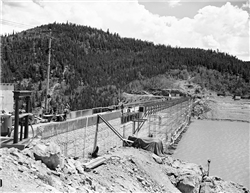Forests are flood mitigation devices, hydrophobic soil is created by fires which leads to increased flood risk.
‘Suddenly you have a healthy forest that has a lot of absorptive capacities for water turns into a concrete parking lot.’ – Andrew Rumbach, Professor of Urban and Regional Planning University of Colorado Denver.
He noted that the issue is state wide, and the downstream effects of debris can cause risk and destruction.
2.5 million acres of forest contribute to Denver Water's supply for roughly 1.8 million people. The vas geographic area leads to a 'whack a mole' problem according to Tony Cheng, Director of the Colorado Forest Restoration Institute.
Fire is needed for a healthy forest, as it provides nutrients for new trees and allows for the ecological cycle to take place. The issue is when nature impacts communtites, or when communities impact nature.

